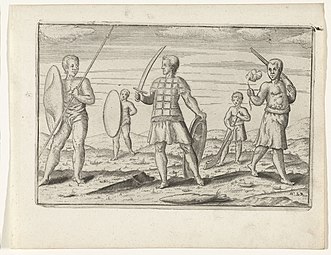Baju Lamina

The baju lamina (also known as lamena by Bugis, sa 'dan by Toraja, lamina or laminah by Malays)[1][2] is a mail and plate armor from the Nusantara archipelago (Indonesia, Malaysia, Brunei, and Philippines).
Description
The baju lamina is a chain armor that is worked in the form of a vest. The back portion consists of small rectangular brass plates, and the front part consists of brass rings. Several rectangular brass plates are attached to the brass rings, which extend from about the height of the collarbone to about the lower edge of the last rib cage. The brass plates serve to reinforce the chain armor at the level of the more vulnerable chest and pelvis. The baju lamina has neither sleeves nor a collar.[1] One of the earliest references to this armor is after the conquest of Malacca by the Portuguese (1511). The son of Afonso de Albuquerque mentioned the armament of Malacca:[3][4]
There are large matchlocks (Java arquebus), poisoned blowing tubes, bows, arrows, armor-plated dresses (laudeis de laminas), Javanese lances, and other sorts of weapons.
It is unknown whether Malaccan armor-plated dresses were used in battle, only used by the elites and nobilities, or if they were purely ceremonial dresses.[5] Rui de Araújo reported that very few soldiers of the Malaccan army wore armor.[6]: 376 Around the 17th century, the Bugis people started using mail and plate armor and they were still used until the 19th century.[7]
Gallery
-
Traditional Bugis or Makassarese lamena armor.
-
Warriors of Banten, 1596.
-
Baju lamina is similar to this Moro mail and plate armor (kurab-a-kulang).
-
Malay baju lamina and kechubong helmet.
-
Bugis brass lamina, with large plates.
See also
References
- ^ a b Albert G. van Zonneveld: Traditional weapons of the Indonesian archipelago. C. Zwartenkot Art Books, Leiden 2001, ISBN 90-5450-004-2, p. 28.
- ^ Klinkert, Hillebrandus Cornelius (1926). Nieuw Nederlandsch-maleisch Woordenboek. N. v. boekhandel en drukkerij voorheen E. J. Brill. p. 546.
- ^ The son of Afonso de Albuquerque (1774). Commentários do Grande Afonso Dalbuquerque parte III. Lisboa: Na Regia Officina Typografica. p. 144.
- ^ Birch, Walter de Gray (1875). The Commentaries of the Great Afonso Dalboquerque, Second Viceroy of India, translated from the Portuguese edition of 1774 volume III. London: The Hakluyt Society. p. 127.
- ^ Charney, Michael (2012). Iberians and Southeast Asians at War: the Violent First Encounter at Melaka in 1511 and After. In Waffen Wissen Wandel: Anpassung und Lernen in transkulturellen Erstkonflikten. Hamburger Edition. Page 2.
- ^ Wijaya, Daya Negri (2022). Malacca Beyond European Colonialism (15th–17th centuries) (PhD thesis). Universidade do Porto.
- ^ Pelras, Christian (1996). The Bugis. Blackwell Publishers. p. 122. ISBN 0-631-17231-9. OCLC 503182095.
Further reading
- Russell Jones (Hrsg.): Loan-words in Indonesian and Malay. KITLV-Jakarta – Yayasan Obor Indonesia, Jakarta 2008, ISBN 978-979-461-701-4.








